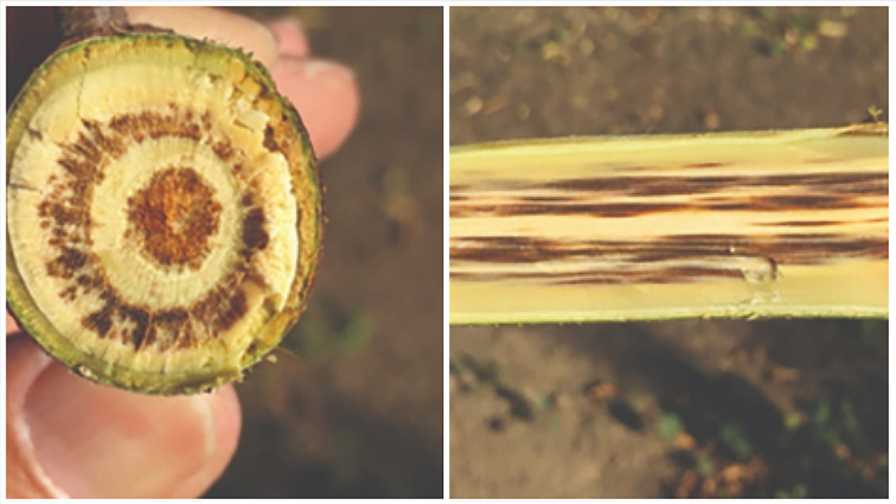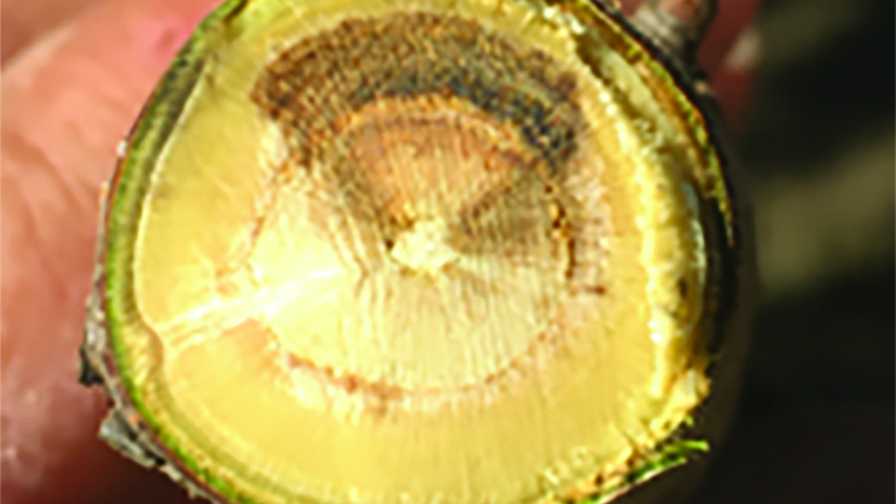Pruning Cuts Can Be Helpful to Spot Almond Tree Ailments

Have you taken a look inside what’s going on in your almond trees? Staining associate with Verticillium wilt are apparent here.
Pruning cuts often reveal internal symptoms in almond trees that may not be evident by observing the foliage. This is especially true if a fungal infection is in its early stages and the outward expression of the typical necrosis, defoliation, or dieback has not yet occurred.
Winter is not the typical time of the year to be discussing two common wood-staining diseases, Verticillium wilt (Verticillium dahlia) and almond silver leaf (Chondrostereum purpureum) since their visual symptoms are evident during the growing season. However, when making pruning cuts, much can be revealed about the incidence and severity of these infections.
During the growing season, the classic terminal wilting with Verticillium (VW) can be seen in May through mid-summer. With milder symptoms, only slightly retarded growth with some leaf burn may show. The dark-stained xylem will show from late spring through winter, though. The terminal wilting can be extensive, and significant portions of the canopy of 2nd through 5th leaf trees can look devastated, but they will usually outgrow this. As dramatic as this may seem, it is a juvenile tree issue and is not seen in mature, bearing trees.
Identification
Early detection is difficult with almond silver leaf (SL) since foliar symptoms are very subtle. And even at advanced stages, only a mild silvering of the foliage may be visible. Long before the typical leaf boating, edge burning, and defoliation is dominant, significant staining of the xylem can be seen in cross section. Ultimately, the scaffolds and limbs will die from the fungal infections in the water-conducting tissue, and a toxin will result in silvering of the foliage. During the advanced stages, basidiocarps (mushrooms) will form spores from the rotting wood and serve as a source for infection of new pruning cuts during rain/wind events.

Almond silver leaf staining symptoms in this cross section of tree limb.
Upon close examination of cross-sectional cuts of infected wood from both VW and SL, the heartwood, or xylem, is the discolored portion. With VW, the staining is very streaky longitudinally, and in cross section, it shows many coalesced rays of darkening in ring-like patterns. With SL, the infected areas are solid and extend from the cambium to the center of the heartwood. It tends to form triangular patterns.
Managing the Pest
Managing the VW requires removal of dead wood and reshaping the tree canopy. With SL, which is infectious and terminal, the trees need to be removed and destroyed by burning.
So how did the SL infections originate? The fungus is commonly associated with riparian areas and trees such as birch, oak, and especially poplars (cottonwood trees) serve as alternate hosts. Orchards planted next to large poplar windbreaks are especially vulnerable to SL infections.
‘Padre’ and ‘Butte’ are the most commonly affected varieties, but recently I am seeing significant SL infections in young ‘Independence’ blocks, so it also appears to be highly susceptible.
The risk of SL infections can be reduced by avoiding pruning during the fall/winter period. If cuts are made during that timing, treating them with Trichoderma can help to reduce infections.










